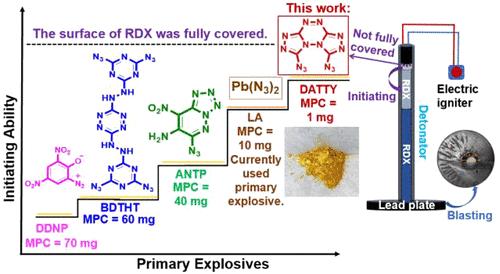探索无金属原爆起爆能力的最大潜力
IF 15.6
1区 化学
Q1 CHEMISTRY, MULTIDISCIPLINARY
引用次数: 0
摘要
叠氮化铅(LA)是一种广泛使用的初级炸药,可作为爆破帽或雷管中的起爆药,启动次级炸药的起爆过程。与 LA 相关的毒性和环境问题导致了监管限制和审查的增加,促使人们开始寻找无铅替代品。LA 对热、冲击或摩擦高度敏感,这给制造、处理和储存过程带来了安全挑战。开发无铅、环保、可恒温、安全且具有高起爆能力的下一代初级炸药是一项重大挑战,也是一个重要目标。本文合成并研究了 1,8-重氮双([1,2,4]三唑)[4,3-b:3′,4′-f][1,2,4,5]四嗪(DATTY)。值得强调的是,DATTY 的含氮量高达 80.3%,摩擦敏感度(5 N)低于 LA(0.3 N),同时在环境条件下稳定。DATTY 是一种高内热初级炸药,其形成热为 6.533 kJ g-1。它显示出卓越的起爆能力,最小一次装药量(MPC)仅为 1 毫克,明显低于洛杉矶的 10 毫克一次装药量,也低于之前报告的其他初级炸药。DATTY 的起爆速度(vD = 8835 m s-1)非常快,超过了所有其他初级炸药。DATTY 的开发标志着初级炸药领域的重大进展,为安全和效率设定了新的基准。本文章由计算机程序翻译,如有差异,请以英文原文为准。

Exploring the Maximum Potential of Initiating Ability in Metal-Free Primary Explosives
Lead azide (LA) is a widely utilized primary explosive, serving as the initiating charge in blasting caps or detonators to start the detonation process of secondary explosives. The toxicity and environmental concerns associated with LA have led to regulatory restrictions and increased scrutiny, prompting the search for lead-free alternatives. LA is highly sensitive toward heat, shock, or friction, which poses safety challenges during manufacturing, handling, and storage. Developing lead-free, environmentally friendly, thermostable, and safe next-generation primary explosives with high initiating ability is a significant challenge and an important goal. Herein, 1,8-diazido-bis([1,2,4]triazolo)[4,3-b:3′,4′-f][1,2,4,5]tetrazine (DATTY) was synthesized and studied. It is important to highlight that DATTY has a high nitrogen content of 80.3%, and a lower friction sensitivity (5 N) than that of LA (0.3 N), while being stable under ambient conditions. DATTY is a highly endothermic primary explosive with a heat of formation of 6.533 kJ g–1. It demonstrates exceptional initiating ability, with a minimum primary charge (MPC) of just 1 mg, markedly lower than the MPC of LA, which is 10 mg, as well as other previously reported primary explosives. The detonation velocity of DATTY (vD = 8835 m s–1) is exceptional, surpassing that of all other primary explosives. The development of DATTY represents significant progress in the field of primary explosives, setting a new benchmark for safety and efficiency.
求助全文
通过发布文献求助,成功后即可免费获取论文全文。
去求助
来源期刊
CiteScore
24.40
自引率
6.00%
发文量
2398
审稿时长
1.6 months
期刊介绍:
The flagship journal of the American Chemical Society, known as the Journal of the American Chemical Society (JACS), has been a prestigious publication since its establishment in 1879. It holds a preeminent position in the field of chemistry and related interdisciplinary sciences. JACS is committed to disseminating cutting-edge research papers, covering a wide range of topics, and encompasses approximately 19,000 pages of Articles, Communications, and Perspectives annually. With a weekly publication frequency, JACS plays a vital role in advancing the field of chemistry by providing essential research.

 求助内容:
求助内容: 应助结果提醒方式:
应助结果提醒方式:


